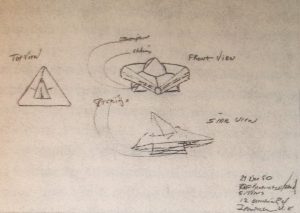Encounter in Rendlesham Forest
Encounter in Rendlesham Forest, The Inside Story of the World’s Best-Documented UFO Incident, by Nick Pope, with John Burroughs, USAF (Ret.), and Jim Penniston, USAF (Ret.). Published by Thomas Dunne Books, An Imprint of St. Martin’s Press, 2014.
The first encounter, in the early hours of December 26, 1980, was an actual landing of the UFO craft. The second encounter, on the night of December 26, involved the sighting by personnel of D-Flight of a fiery red/orange object that descended slowly into the forest. It was surrounded by an eerie blue/white corona. The third encounter took place from the evening of the 27th through the next morning, and several challenging UFOs with beaming lights were witnessed.
On December 26, the strange intense lights of the first encounter were seen in the forest outside the East Gate of the Woodbridge US Air Force base. At that time the Bentwaters and Woodbridge NATO bases, on British soil, were staffed by Americans. The twin bases were in “the sleepy county of Suffolk on the cold, exposed coast of the East of England,” an area described as “creepy” and “weird” by service personnel. The Rendlesham Forest was between the two bases. The red and blue lights were spotted by Airman First Class John Burroughs, who had been patrolling Woodbridge near the East Gate. He contacted his supervisor, Staff Sergeant Bud Steffens, and both drove out to a small track that led into the forest. An odd white light had also become visible. They returned to the base to inform others, including the on-duty flight chief at Woodbridge, Staff Sergeant and NCO James (Jim) W. Penniston, who thought there might have been an aircraft crash. As it turned out it was not a crash, it was a landing. “In the clearing was a small, metallic craft. It was about three meters high and maybe three meters across at the base. The craft was roughly triangular in shape … It had a bank of blue lights on its side and a bright white light on the top. There was no sound whatsoever. Penniston “had the presence of mind to take a number of photographs.” Unfortunately, the photography failed, probably due to high radiation levels. But Penniston managed to sketch both the craft and its symbols in his police notebook.
He also “plucked up the courage to touch the object. It felt hard and smooth, like a smooth, opaque glass.” However, when he touched the symbols, “they were rough, like running my hands over sandpaper.” The craft responded to Penniston’s touch with a white light at the top that “flared up and became so intense that Penniston was fear struck and temporarily blinded …” After a time, the craft rose above the trees, taking two or three minutes, and then “accelerated away in an instant.” It was noticed that three indentations were left on the hard, frozen ground, and that the line between them formed a near-perfect equilateral triangle. Later, plaster molds were made of the indentations. More »


